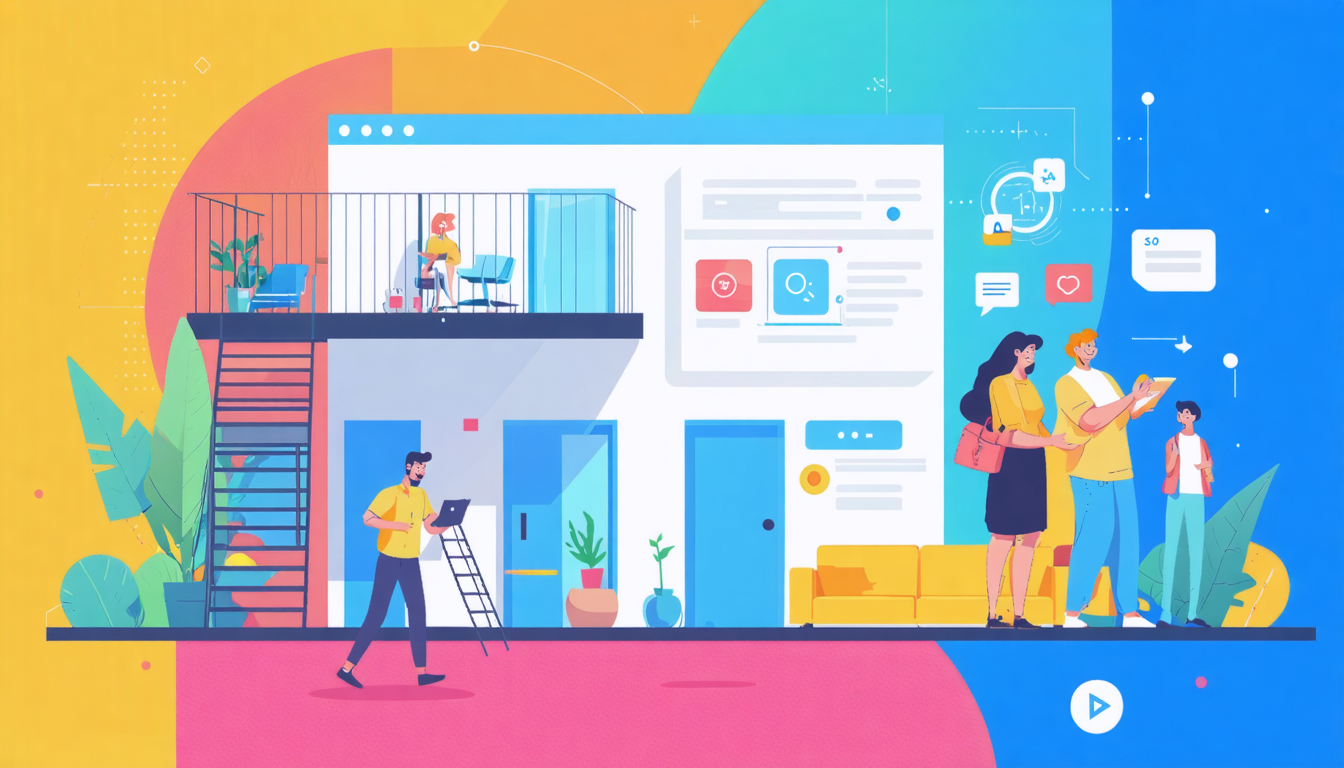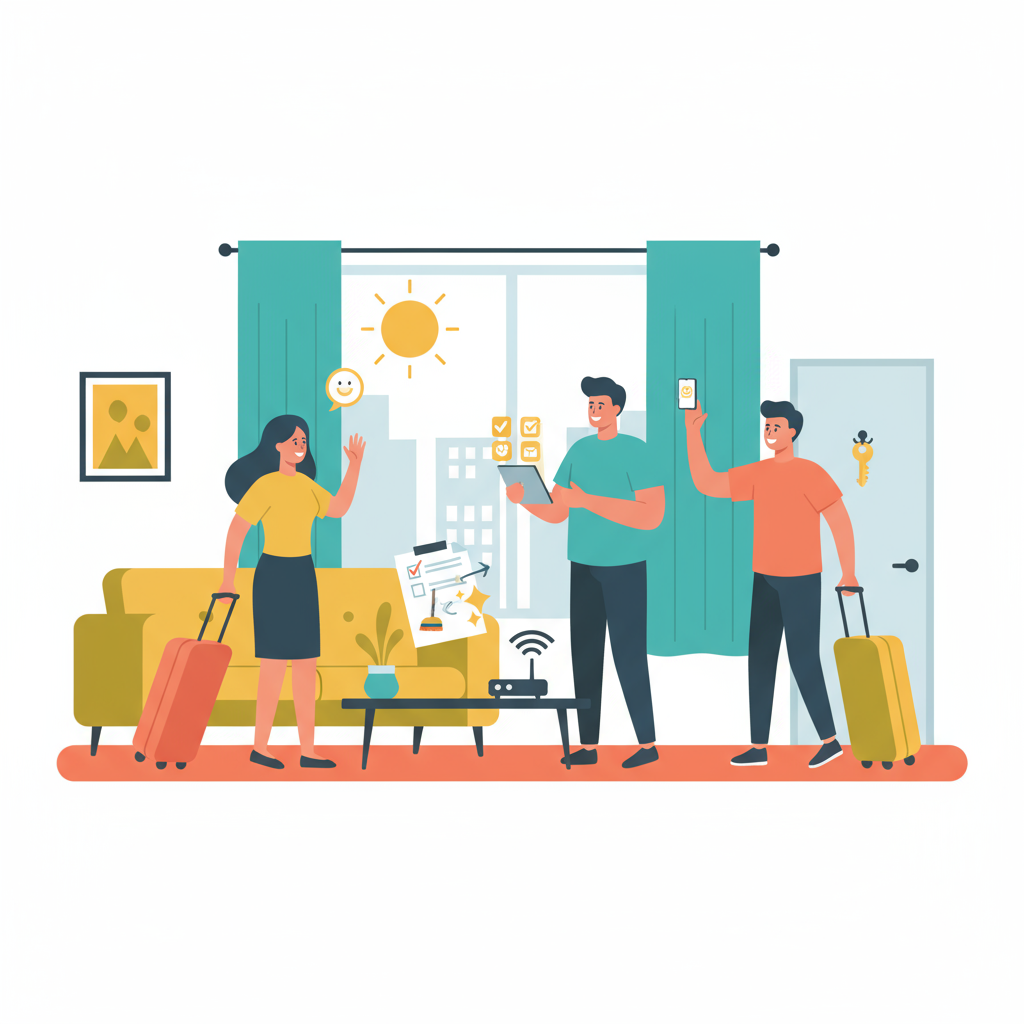Key Takeaways
Guest experience is often won or lost on small, overlooked details
To make improvements, you don’t need to overhaul your listing. Quick, thoughtful updates make a difference.
Speed matters: improvements you can implement this weekend help you compete faster.
A guest walks into one of your properties. The check-in was smooth, the room smells fresh, the Wi-Fi instructions are exactly where they should be, and the bed looks like it belongs in a boutique hotel.
Now breathe. That's the moment, when everything just works, that makes it all worthwhile. It’s also what drives better reviews, repeat bookings, and fewer support messages clogging up your inbox. However, getting that moment on repeat often means making strategic improvements to your processes.
For hosts managing multiple short-term rentals, improving Airbnb guest experiences doesn’t need to mean a full-scale renovation or a line item in next quarter’s budget. The right fixes can be low-effort, low-cost, and high-impact... All doable this weekend, in fact!
In this blog, we're breaking down Airbnb guest experience improvements that help you stay ahead in a saturated market while keeping stakeholders confident in your performance.
Why Small Guest Experience Fixes Matter
Most guest complaints don’t come from disasters, but from missed details. A hand towel isn’t where it should be. Wi-Fi instructions are buried in a message thread. Light switches don’t control what guests expect. Individually, none of these issues seem major. Together, they add up to that “almost perfect” kind of feeling that leaves you with four star and not five star reviews.
The good news: you can fix a lot of what matters most over a weekend when you focus on the parts of the stay where things tend to go off-script, like those moments where expectations hit friction, and the experience starts to feel less polished.
Quick, low-cost updates often go further than expensive upgrades. A labeled switch. A bedside charging station. A printed guide with icons instead of walls of text. None of it takes long, and all of it scales.
Guests ask fewer questions: Clear instructions and intuitive layouts reduce messages and late-night calls.
Reviews improve: The first few minutes shape the stay. Nail those, and you’re already ahead.
Fixes apply across properties: One update can roll out to ten listings without extra effort.
Enjoy the confidence & focus you need to scale your vacation rental business
Book more while doing less
With a reliable VRM solution you can trust, Uplisting can help you grow your business without wasting time on double bookings, unhappy guests, upset clients and worrying what could go wrong next.
Tip 1: Add Clear Arrival Instructions
No one wants to feel lost after a delayed flight and a long drive. Guests expect a smooth arrival, not a scavenger hunt to figure out which door leads to their stay. Clear instructions upfront remove any guesswork and make the first impression feel effortless.
Photos help instantly. Include a wide shot of the building from the street, a close-up of the keypad or lockbox, and any tricky turns or landmarks along the way. Guests don’t need to guess what the door looks like or where to park when the directions show them exactly what to look for.
Double-check how the address appears on Google Maps or Apple Maps. If the listing sits on a private road, behind a gate, or includes a unit number not clearly visible from the street, make sure the message reflects that. For remote areas with spotty signal, add a downloadable guide or a pinned location link they can open before leaving Wi-Fi.
Set your system to send a message automatically 24 hours before check-in with everything they need: the door code, check-in time, Wi-Fi info, parking instructions, and what to do if something doesn’t work. Include a clickable map and a quick reminder to message through the platform for support.
This simple prep step is one of the fastest Airbnb guest experience improvements you can make. It cuts down on last-minute questions, avoids missed check-ins, and makes the stay feel smooth from the start.
Tip 2: Upgrade Your Welcome Setup
A clean, simple welcome station with a few helpful touches tells guests they’ve booked a place that’s run by someone who pays attention, and knows what makes a stay comfortable.
A small tray or basket near the front door or on the kitchen counter works well. Use it to hold a printed card with the Wi-Fi name and password (bold, easy to read), emergency contacts, and check-out reminders. Guests shouldn’t have to scroll through message threads or dig through apps to get the basics.
Now add something small they weren’t expecting, like a snack basket with granola bars, bottled water, or a sample of a local treat. Even a handwritten note with a mint or two makes the place feel personal. The goal isn’t to impress with volume. You’re aiming for thoughtful and tidy.
Create a local connection
Out-of-towners often land hungry, tired, and clueless about where to go. A short printed guide with guest-friendly suggestions nearby (like a late-night pizza spot, a 24-hour pharmacy, or the closest place to grab a charger) saves them time and questions. Skip national chains. Locally owned always feels more authentic.
Keep the layout clean. Use headings, icons, and bold type for quick scanning. If you manage listings across different neighborhoods, tailor each guide so it’s specific to where guests are staying. Guests can tell when recommendations feel copied from another property, and they’ll trust your suggestions more when they’re clearly handpicked.
A welcome setup that’s easy to spot and quick to use sets the tone before a guest even unpacks. It answers questions you’d rather not field at 10 p.m. and shows you’ve already thought two steps ahead.
Create 5-star guest experiences
Give your guests unforgettable experiences
With Uplisting, you can send the right messages at the right time on all booking sites. Read and respond to guest messages in a single, unified inbox — whether you’re at the office or on the go.
Tip 3: Improve Sleep Quality
Guests don’t just book a short-term rental to drop their bags... They book it to get quality sleep! A restless night turns even the best-designed space into a forgettable experience. Flat pillows, traffic noise, and light leaks often show up in reviews without being called out directly. You’ll see it between the lines: “slept okay,” “nice place, but bring earplugs,” or “bed could be better.”
Walk through the bedroom at night like a guest would. Notice the sounds from the fridge, upstairs neighbors, or nearby traffic. Look for any light sneaking in through the windows. A glowing street lamp or hallway light can make a room feel like a stage. Guests won’t always mention it, but they’ll feel it—and rate accordingly.
Control light and sound distractions
Block outside light with real blackout curtains. If the bedroom faces a street, install double rods to keep drafts and light out. The fix is fast, and the difference is immediate.
Add a white noise machine or small fan if the property sits near a busy road or above a restaurant. These small additions help guests block out noise you can’t fix. You don’t need to gut walls or install soundproofing. Just give guests a way to tune out.
Upgrade the essentials, offer backups
Old pillows flatten fast. Replace them with medium-firm options that work for most sleep styles. Keep two extras in the closet, and label the firmness to make the choice easy. Some guests sleep on their side, others on their back. Offering options shows you’ve thought ahead.
If the mattress feels tired, add a memory foam topper. It’s a quick fix that changes how guests feel about the entire space. Make sure bedside lighting is soft and reachable, and add charging ports within arm’s reach. Tucking away these updates across all listings can lead to fewer complaints, better reviews, and fewer guest messages about sleep issues.
Among the fastest Airbnb guest experience improvements you can make, sleep upgrades pay off right away.
Tip 4: Add Easy Tech Touches
Smart tech doesn’t need to be fancy or expensive to make a difference. The most helpful upgrades are the ones guests barely notice because everything just works. Simple tech changes can quietly improve the stay and reduce support requests across every property.
Label remotes and centralize charging
The charging setup is crucial, especially near the bed and living area. Wall outlets hidden behind furniture don’t help anyone and for many travellers, finding a place to charge is a number one priority as soon as they step over the threshold.
Add a visible charging station with USB-A and USB-C ports. Toss in a couple of cables, one for iPhone, one for Android, and you'll definitely score some points from international late night arrivals who packed their charger at the bottom of their suitcases.
Leave clear instructions for streaming
Guests often arrive tired, plug in their phone, and try to stream a show. Then comes the confusion: three remotes on the table, none labeled, and no idea which one controls what. Not to mention, who remembers their Netflix password?
Fix this inconvenience instantly by adding clear labels to each remote. Use bold text or icons: TV, Soundbar, Streaming. If a universal remote handles everything, include a one-page cheatsheet with the basics—input toggle, volume, power. Guests shouldn’t need to guess, and you shouldn’t get another “TV won’t turn on” message. Finally, a shared guest profile on Netflix, Prime, or Hulu solves the password problem and avoids forgotten logouts.
When tech works without effort, it fades into the background. That’s when it actually improves the stay.
You’re in great company
Sign up
Some of the largest short-term rental operators (with 250+ properties) rely on Uplisting's software to scale their businesses.
Tip 5: Refresh Your Listing Info
An outdated listing quietly chips away at guest confidence. Old captions, inaccurate photos, or missing details create friction before anyone even books. Updating listing info is one of the fastest Airbnb guest experience improvements you can make over a weekend.
Revisit your photos and captions
Photos only help when they reflect what’s actually in the space. Added blackout curtains? Upgraded the coffee station? Switched out the sofa? Swap in new photos that show those updates. A full reshoot isn’t always necessary... Well-lit phone photos can do the job until you schedule a professional session.
Captions aren’t just placeholders. They guide expectations. Instead of “cozy living room,” call out the smart TV or sleeper sofa. If a photo shows stairs, add a note about how many steps there are and whether they’re steep. Mention practical updates like ceiling fans, white noise machines, or blackout curtains so guests know what kind of sleep setup they’re walking into.
Anticipate guest questions
Any repeated question in the inbox or review section points to a gap in the listing. Add a “What to Expect” section in the description to answer common concerns before they’re asked. Be specific:
Stairs: How many? Are they indoors or outdoors?
Parking: Is it free, street level, in a garage, or shared?
Noise: Is the property above a bar, near traffic, or next to a construction site?
Accessibility: Are entryways step-free? Is the bathroom tight or spacious?
Say exactly what guests need to know in a way that’s skimmable and honest. A clear, accurate listing builds trust long before check-in.
Tip 6: Do a “Guest-Eye” Walkthrough
Step through the front door like you’ve never seen the space before. Don’t bring a host’s checklist, bring a suitcase, a tired brain, and a phone running low on battery. What stands out right away? What’s missing or unclear?
Start from the curb. Is the unit number visible from the street at night? Does the entry make sense, or do guests have to guess which gate or door leads to their place? Once inside, pause for a second. Can you find the light switch without guessing? Does the first view feel clean and welcoming, or cluttered and cold? First impressions don’t leave much room for error.
Check what guests touch first
Go room by room and test the most-used features:
Light switches: Are they labeled, especially when grouped together? Unmarked panels lead to confusion and guest messages.
Locks: Does the code work on the first try? If the deadbolt sticks or feels awkward, fix it now.
Thermostats: Can someone figure it out without instructions? Most guests won’t search online for a model number.
Appliances: Run the coffee maker. Try the toaster. Open the microwave. Look for grime, broken parts, or anything that needs updating.
Bathrooms often hide small issues that snowball into bad reviews. Turn on the shower, how long does hot water take? Does the drain clog? If you’d be annoyed by the delay or mess, your guest will be too. In the kitchen, open every drawer. If one screeches or sticks, replace the hardware or oil the tracks.
Spot what feels awkward or overlooked
Now take a seat, on the sofa, at the table, on the bed. Look around from each spot. Are cords hanging everywhere? Are light fixtures dusty? Are there leftover toiletries in cabinets? Guests notice what’s in their line of sight, and small things like visible extension cords or a scuffed wall quickly make a place feel neglected.
From there, test the layout. Can you plug in a charger next to the bed without moving furniture? Is the TV setup obvious? If the coffee table wobbles or the lightbulbs flicker, fix them before they turn into complaints.
Save yourself from your inbox
Automate with Uplisting
Automated guest messages keep your guest informed from booking through to check-out. They’re designed to answer questions before they arise, saving you time whilst keeping your guests happy.
Tip 7: Streamline Guest Messaging
Guests don’t want to scroll through five messages to find a door code, or wonder if checkout means locking the front door or just leaving the key on the counter. Clear communication removes confusion and gives each stay a smoother rhythm.
Start with three message templates: one before arrival, one mid-stay, and one before checkout. Each should focus on timing and clarity. The pre-arrival message sets expectations. Include check-in time, smart lock code, parking info, Wi-Fi details, and a few quick tips for using things like the thermostat or coffee machine. Add a short FAQ to answer common questions, like where to take trash or whether the tap water’s safe.
A mid-stay message can be short but effective. Something like, “Hope everything’s going smoothly, just let us know if anything’s off,” works well. Send it about 24 hours after check-in. That timing catches small issues before they turn into problems later.
The checkout message should feel just as smooth. Remind guests of the checkout time, provide a short list of what to do before leaving (lock up, gather all chargers, drop towels in the tub), and thank them for staying. Include a link for reviews, but keep the tone casual and confident, not pushy.
Automate the flow without losing the tone
Once the messages are ready, set them to send automatically. Use triggers based on check-in and checkout times (not just dates) so messages land when guests actually need them. For example, a 4 p.m. check-in message should arrive mid-afternoon, not first thing in the morning.
Keep the tone consistent across every listing. Whether you manage six properties or sixty, the guest experience should feel equally polished across the board. A friendly, helpful message at the right time makes things easier for guests and for your team.
When messages run behind the scenes, they remove work from your plate while making the stay feel more thoughtful. Strong communication is one of the fastest Airbnb guest experience improvements you can put in place, especially when you don’t want one more thing to manage on a busy weekend.
What to Remember About Improving Guest Experience
Small details shape big impressions. By tightening up arrival instructions, upgrading sleep essentials, refreshing your listing, and automating communication, you create a smoother, more memorable experience for every guest. These seven improvements don’t require a major budget or weeks of planning, they only need a focused weekend and a commitment to quality.
When every element of the stay feels intentional, guests notice. Fewer questions, better reviews, and higher occupancy follow naturally. As you scale your operations, these changes compound, saving your team time, reducing friction, and helping your properties stand out in a crowded market.
Ready to put these improvements on autopilot? Sign up for Uplisting to streamline your vacation rental management.
All-in-one Vacation Rental Software and Channel Management System
Get started in seconds by connecting Airbnb
Manage short-term rentals & bookings, message guests, take payment, and so much more. All in one easy-to-use platform (that never double-books).
FAQs about Airbnb Guest Experience
How do I speed up my guest communication without losing personalization?
Automated messages can still feel personal when written with care. Start with message templates that handle repetitive info, like check-in steps, Wi-Fi passwords, or checkout times. Then add quick personal touches, like the guest’s name or a note about the weather or local events happening during their stay.
It only takes a few seconds to customize when all conversations land in one unified inbox. You respond faster, stay organized, and guests still feel like someone’s paying attention.
Do flexible payment plans really boost my bookings?
Yes, especially for longer stays or higher nightly rates. Hosts in short-term rental forums often mention fewer booking drop-offs after enabling “Pay Part Now, Part Later” options.
Airbnb’s own rollout of flexible payments backs that up with consistent adoption and positive guest feedback. When guests don’t feel financial pressure all at once, they’re more likely to complete the booking. Fewer abandoned carts, more confirmed reservations. It’s a straightforward Airbnb guest experience improvement that also supports revenue goals.
What if my property has unique check-in quirks?
If the front door sits behind a gate, the lockbox sticks, or the parking spot isn’t obvious, don’t bury the explanation in a long message. Short videos or a few labeled photos make everything clearer. A 30-second phone video showing how to enter the building or where to park makes more sense than a paragraph trying to describe it.
Drop the link into your pre-arrival message so guests feel confident when they arrive. Clear instructions upfront reduce stress and keep reviews focused on what went well, not the hassle of finding the right door.














.png)

